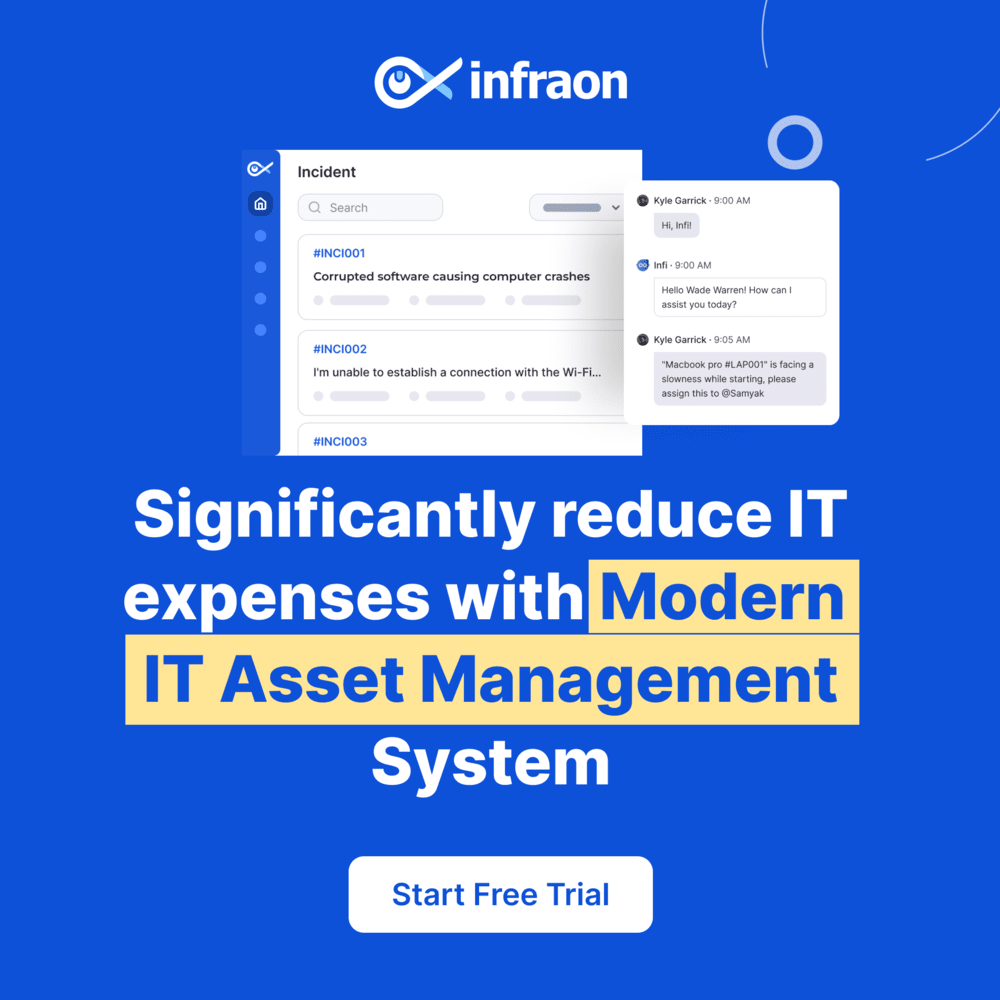Hardware Asset Management (HAM) is a serious consideration for fast-growing enterprises that are constantly scaling and evolving. HAM ensures that hardware resources remain aligned with the organization’s evolving needs and budget constraints. It prevents the accumulation of redundant or obsolete hardware, thereby optimizing resource allocation. Moreover, robust HAM aids in compliance with regulatory requirements, safeguarding against potential legal and financial repercussions that can impede growth.
MSPs and IT managers help such enterprises to navigate the challenges of HAM. MSPs bring their specialized expertise in managing and maintaining hardware assets, complementing the IT managers’ understanding of internal workflows and business objectives.
In this blog, you’ll learn about how MSPs and IT managers collaborate and ensure hardware asset management success.
Related blog: Emerging Trends in Hardware Asset Management Tools and Their Impact on IT Asset Management
Impact of MSPs and IT Managers on the HAM Lifecycle
Acquisition management
The acquisition stage is crucial for setting a strong foundation in hardware asset management. MSPs and IT managers collaborate to:
- Conduct in-depth research on potential hardware items, leveraging MSPs’ extensive market knowledge alongside IT managers’ deep understanding of the organization’s specific needs
- Determine the compatibility of new hardware with existing systems, ensuring seamless integration that minimizes disruption and maximizes efficiency
- Negotiate contracts where MSPs can use their industry connections and bulk-purchasing capabilities to secure favorable terms and pricing
- Oversee the purchasing or leasing process, focusing on cost optimization without compromising quality or performance requirements
- Set up the hardware in a manner that integrates the technical expertise of MSPs with the practical, day-to-day operational knowledge of IT managers, ensuring a smooth transition and deployment
Inventory management
Inventory management is a huge aspect of controlling and managing assets. In collaboration, MSPs and IT managers ensure:
- Accurate and comprehensive tracking of physical items, including computers, servers, and other IT equipment, to maintain an up-to-date record of all hardware assets
- Proper management of software licenses and other digital assets to avoid legal issues and ensure compliance
- A unified approach to monitor asset distribution and usage across different departments and locations, enabling better resource allocation and preventing asset underutilization
Hardware deployment
Deployment is an important phase that involves integrating hardware into the organizational IT environment. This stage includes:
- Coordinated installation of hardware and software, where MSPs provide technical expertise and IT managers ensure alignment with internal processes and policies
- Careful configuration of hardware assets to align with organizational needs, user preferences, and operational requirements
- Integration with current IT systems, wherein MSPs offer additional support to ensure that new hardware works within the established IT infrastructure
Hardware asset maintenance
Maintenance is the key to ensuring hardware assets are updated and perform optimally. Through collaboration, organizations benefit from:
- Regular and thorough maintenance routines that keep hardware dependable, thereby enhancing overall business operations
- Cost-optimized strategies developed jointly to extend the life of hardware assets, thereby reducing the total cost of ownership and environmental impact
- Routine checks and balances, including performance assessments and audits, to maintain high performance and compliance standards
Hardware asset retirement
Retirement is an essential phase in the hardware asset lifecycle, involving the decommissioning and disposal of assets. The collaborative process helps:
- Implement data sanitization and secure disposal practices to safeguard sensitive information contained within hardware being retired
- Optimize the utilization of assets right up to their retirement, including potential resale or recycling, ensuring environmental responsibility
- Maintain compliance with industry and environmental standards, avoiding legal pitfalls and upholding corporate responsibility
Hardware asset reporting
Comprehensive reporting is important in acquiring and analyzing data on hardware assets. Joint efforts facilitate:
- Detailed tracking of asset age, location, cost, availability, and utilization, providing valuable insights for strategic planning
- Maintenance of comprehensive maintenance history records, which aid in predictive maintenance planning and future asset procurement decisions
Benefits of Collaboration between IT Managers and MSPs
Enhanced asset security
Collaborative efforts lead to the development of robust security protocols, combining the internal knowledge of IT managers with the external expertise of MSPs. This synergy results in more comprehensive security strategies that safeguard hardware against unauthorized access, cyber threats, and potential physical vulnerabilities.
IT managers gain access to advanced security tools and practices through MSPs, while MSPs benefit from organization-specific insights. This results in a well-rounded approach to security that addresses both general and unique organizational risks.
Regular security audits and updates become part of the collaboration, ensuring that security measures evolve with emerging threats and technological advancements, thereby maintaining a consistently high level of protection for the hardware assets.
Optimal resource utilization
The collaboration ensures that resources are utilized in the most efficient manner possible. IT managers’ intimate knowledge of the company’s operational needs, combined with MSPs’ broad view of technological possibilities, leads to more strategic resource allocation and utilization.
This joint effort minimizes waste by ensuring that hardware assets are neither underutilized nor overburdened, leading to optimal performance and extended asset life cycles.
MSPs can introduce automated tools and analytics for resource management, allowing for real-time adjustments and proactive planning, which enhances the overall health of hardware assets.
Streamlined asset database
MSPs contribute with advanced database management systems and analytics tools, while IT managers provide the necessary organizational data and context. The collaboration results in a database that captures each asset’s information and integrates usage patterns, maintenance schedules, and cost analysis.
An unparalleled asset database offers insights for strategic decision-making, helping organizations anticipate future needs and make informed investments in their hardware infrastructure.
Smart hardware tracking
Tracking hardware across its entire lifecycle becomes a much more manageable and accurate process with the combined capabilities of MSPs and IT managers. MSPs offer sophisticated tracking tools and systems, while IT managers provide the necessary customization and alignment with internal processes.
The integrated approach ensures that every stage of the hardware lifecycle, from acquisition to retirement, is monitored, providing valuable data for asset optimization and compliance. It also allows for the implementation of predictive maintenance and proactive upgrades, ensuring that hardware downtime is minimized.
If you need more information on MSPs and hardware asset management, please explore www.infraon.io























